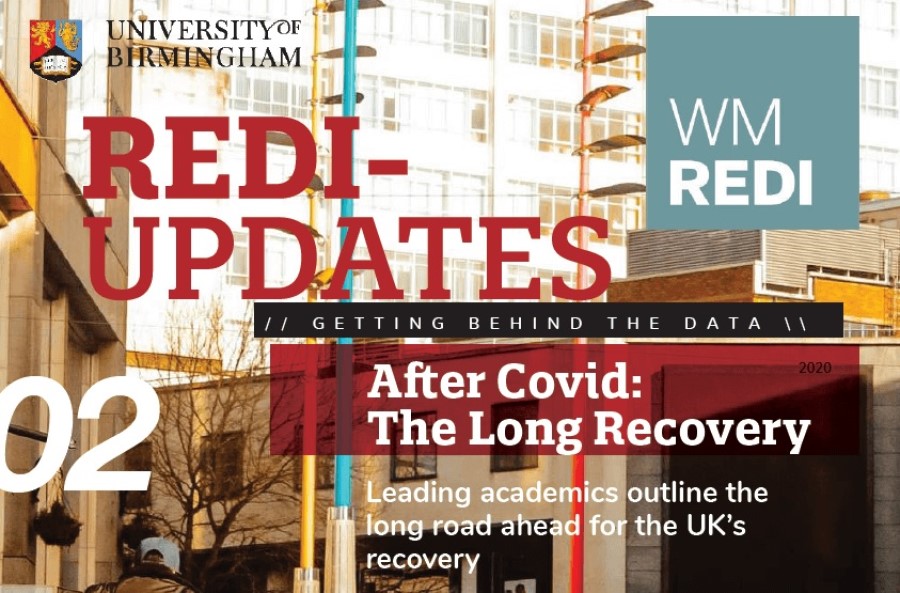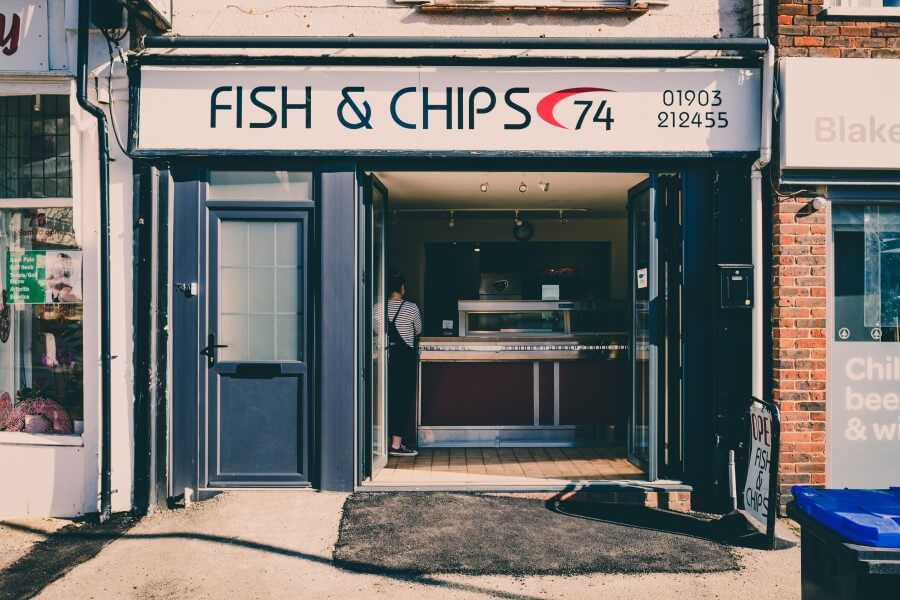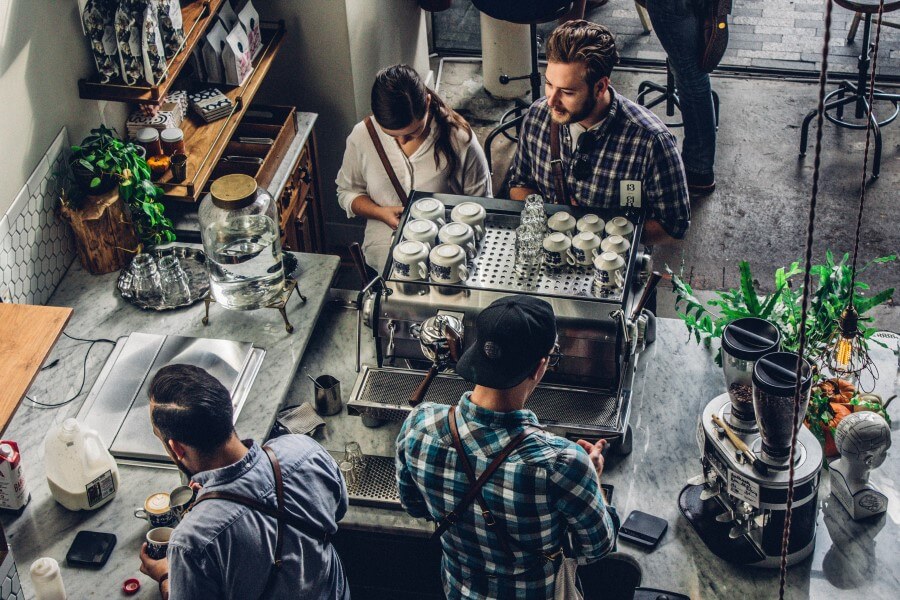
Welcome to REDI-Updates. REDI-Updates is a bi-annual publication which will get behind the data and translate it into understandable terms. In this edition, WM REDI staff and guest contributors will discuss some of the key topics when trying to understand the long-term economic impacts of the pandemic. In this article, Rebecca Riley looks at the economic, social, and mental health impacts of the pandemic on cities and towns, and asks what can be done to support all of these in the long term.
Post the general election the policy focus shifted from cities to towns. The seismic shift in the political landscape and the notion of the ‘red wall turning blue’ driven by local dissatisfaction in towns across the north and the midlands shifted government thinking in ways many might have seen as unthinkable. The impact of Covid-19 has seen further unthinkable shifts in towns and cities. Social distancing and the shift to homeworking has created significant shifts in the way people work and interact. Cities have become the epicentre of outbreaks and proximity has become a friction.
Lockdown has emptied out cities and urban environments and may lead to greater de-urbanisation as people seek green space and better home environments. Big Tech and personal based service hubs have increased their share of employment in the past and growth generated from intense agglomeration still remain important to these businesses in terms of staff, idea exchange and innovation.
The emptying out of cities could accelerate the wealth divide with those able to afford to move out, moving to towns and suburbs, utilising the flexibility of working from home more, leaving the young and poorer communities concentrated in the urban inner city. This would affect the infrastructure demand in cities and the disparity between where money is earned and where it is spent. Globally, however, during the last recession cities grew, gaining migrants and millennials unable to find jobs elsewhere. This time around the future of cities relies more on the decisions on Generation-Z. They are more educated and more diverse and already have strong urban roots. They are a generation committed to environmental protection, supporting local businesses and shared assets, less inclined to see homeownership as a necessity and accepting that they will have less than the generations before them.
The Covid-19 experience may accelerate a lot of these traits in wider society. The pandemic may accelerate the decline of the high street, where the number of shops could more than halve in the next two years, but this is a trend that was already in play. High streets which have thrived are the ones which have picked up on and maximised some of the other trends which have accelerated under covid-19 conditions, including, personalised, ethical and local businesses and embracing online sales to diversify markets.

Creative and innovative leadership
Reviewing the evidence for and against cities, some themes emerge on the challenges facing places (big and small). Reviewing these themes against Covid-19 impacts we can see there are lessons to be learnt from the trends already developing and how successful places have adapted and changed to revive high streets that many need to be applied post-pandemic.
There are often institutional failures, where places fail to set a clear vision or agreed goals, and places lack a positive narrative on which to build, so citizens have a lack of engagement and pride in their local areas. Thus there is a need to invest in community leadership, invest in capacity to mobilise action and invest and attract good staff that can perform and understand the evidence.
Understanding and analysing the reality of the place, using evidence, developing outcomes, creating action and ensuring delivery all become harder if institutions cannot attract and retain good staff to lead thinking. There can also be a tendency to misalign economic, social and environmental goals at a place level, due to silos of activity at a national level, conflicting government policy lands at the local level and can create interventions which act against one another, such as employment goals versus productivity goals. Places have mobilised quickly to deal with Covid-19 despite these constraints. Future investment in community leadership which enhances the capacity of political, community and local government leaders is needed. Training and skills development for vision setting, future scoping, programme and strategy development, implementation and evaluation will all enable good decision making at the local level. Leaders should be given the skills, tools and expertise to drive and embed the approaches such as the United Nations Sustainable Development Goals locally, based on good data and understanding of their place to ensure recovery is long-lasting and fair.
Meaningful community engagement
Similarly, there are democratic or information failures where communities are not engaged in decision making. Post pandemic this is particularly important as people need to deal with feelings of powerlessness and mental health impacts. These may be caused by a lack of knowledge on how to engage, lack of routes for engagement, or because it is difficult to get communities engaged and interested in the place because of feelings of disempowerment. Covid-19 has seen the way technology is changing the way people interact with place. There may also be a lack of knowledge and expertise within communities on how to make a positive change locally.
There is the need to accelerate technological adoption with democracy platforms that engage directly with citizens on key issues; training councillors on engagement and proactively seeking views; reviewing the evidence for technology-driven solutions and how they sit alongside face to face engagement.
Understand your Unique Selling Point
A place must understand its unique selling point. It is vital that there is an understanding of the past, present and potential futures of place, and there is a lack of evidence used in identifying the uniqueness of place, alongside the basics of what purpose a place has. The smart specialisation approach is poorly adopted in the UK which means places fail to really understand their unique asset base and capitalise on it.
This includes understanding your assets base: technology, people, culture, environment, innovation and business, and using it to differentiate. Collaborate with neighbours to complement assets and protect and nurture your asset base and build it into your place offer. It is important to ensure the science and innovation assets are built into the thinking around the specialisation of place, as these present business growth opportunities and prospects and investment can then be tailored to meet local needs. This will ensure innovation supports jobs growth around the assets and opportunities.
Competitive, safe, socialising and experience
There has always been a need to understand the local demand for socialising, the retail, entertainment and liveability offer and what local residents demand and want, alongside attracting those from outside. Post Covid-19 this is now a difficult balancing act, between keeping people safe and ensuring people can return to the shops, cafes and entertainment offer is essential not just for the economy but for wellbeing. Lack of contact, socialising and engagement with people is taking its toll on mental health.

Let there be light, blue and green infrastructure
Research into the success of towns was already pointing to a lack of good spaces for interaction with place, open green infrastructure was already seen as a disadvantage. Covid-19 has exposed this as a major issue affecting health and wellbeing in a lockdown scenario under-investment in green and clean infrastructure and brownfield derelict land (which is now at the hardest to clear levels, as easy areas have already been developed), now makes the costs of investment much higher. Green infrastructure is lacking in post-industrial towns and dense urban cities, parks, waterways and access to clean air and light are at a premium but post-pandemic are now seen a core basic needs.
There already was a lack of good quality housing infrastructure and undersupply. We do not know yet the effect of the pandemic on the boom in city-centre living, and whether the demand for outside space will change the way cities and towns need to provide for residents as demand shifts. To ensure places are attractive, to help drive consumer spend and support local businesses, there needs to be investment and adaption in the public realm that improves the environment, clean transport, walking and cycle paths, good integrated public transport, investment in green space and waterways to add to the social fabric of places, and engagement with business and communities on the use of space post Covid-19.
Create a place for caring and community
Developing mixed-use, open experience markets, and investment in new infrastructure could support this shift. A review of business rates, compulsory purchase order capabilities of disused shops and bringing them back into usage could accelerate this change. Greater investment in new innovative independent businesses which bring people back to the high street, start-up support for businesses that take risks and add to the local offer, and creating high-quality market environments that enhance local place-making and attract new visitors or become meeting places for residents is essential at the local level. Seeing cities as interconnected neighbourhoods that are distinctive and serving diverse, local communities and cultures build local resilience and attractiveness.
Connectivity which enables interaction
A major issue which has emerged in the pandemic is access to safe travel, current social distancing measures restrict the use of most public transport and make them unviable, and for many, this is their only means of transport. The levels of commuter travel may never return – especially for knowledge workers who can deliver their role remotely. This has significant impacts on the system and its use by people who need to still get to work because their role requires face to face interaction or needs to be situated in a specific place. This means a need for investment in wider forms of transport to enable people to travel safely and have confidence in the system. Transport needs to be geared towards helping people maintain their health and distributing travellers across a wide range of options, including investment in walking and cycling which maximises safety and the environment. The boom in technology has exacerbated any issues with digital connectivity, either hard infrastructure or skills
Research on successful towns and cities had already highlighted that places which build a sense of community and invest in the social fabric were more successful. Encouraging the local population to invest, spend time and money on local businesses creates a more resilient local ecosystem, and the points above all add to this. Central to that is create a sense of community. The pandemic generated that quickly and the hope and sense of community spirit were evident not just in practice but in the data with people reporting higher levels of community engagement. However, many have also experienced significant mental health strain, either economic, physical or mental fear.
Looking to the future this could have significant long term effects on residents, their ability to participate in society and achieve long term fulfilment. Investment in approaches which continue to support mental health is vital going forward. Resilient communities are skilled, adaptable and educated, recession usually forces people to invest in their own skills and adapt and this should be capitalised on. The pandemic has also created a greater understanding and appreciation of how important those people who keep our communities running smoothly are, those that care for us, keep our places running and protect the vulnerable. Developing local approaches that continue this momentum and also invests in the systems which support this sense of community especially can build local pride and grater individual investment in the places they live.
This blog was written by Rebecca Riley, City-REDI / WM REDI, University of Birmingham.
Disclaimer:
The views expressed in this analysis post are those of the authors and not necessarily those of City-REDI or the University of Birmingham
